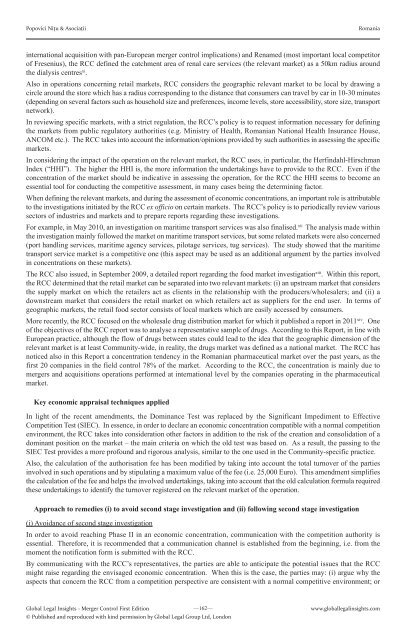Merger Controls First Edition - J Sagar Associates
Merger Controls First Edition - J Sagar Associates
Merger Controls First Edition - J Sagar Associates
Create successful ePaper yourself
Turn your PDF publications into a flip-book with our unique Google optimized e-Paper software.
Popovici Nițu & Asociații Romania<br />
international acquisition with pan-European merger control implications) and Renamed (most important local competitor<br />
of Fresenius), the RCC defined the catchment area of renal care services (the relevant market) as a 50km radius around<br />
the dialysis centresxi .<br />
Also in operations concerning retail markets, RCC considers the geographic relevant market to be local by drawing a<br />
circle around the store which has a radius corresponding to the distance that consumers can travel by car in 10-30 minutes<br />
(depending on several factors such as household size and preferences, income levels, store accessibility, store size, transport<br />
network).<br />
In reviewing specific markets, with a strict regulation, the RCC’s policy is to request information necessary for defining<br />
the markets from public regulatory authorities (e.g. Ministry of Health, Romanian National Health Insurance House,<br />
ANCOM etc.). The RCC takes into account the information/opinions provided by such authorities in assessing the specific<br />
markets.<br />
In considering the impact of the operation on the relevant market, the RCC uses, in particular, the Herfindahl-Hirschman<br />
Index (“HHI”). The higher the HHI is, the more information the undertakings have to provide to the RCC. Even if the<br />
concentration of the market should be indicative in assessing the operation, for the RCC the HHI seems to become an<br />
essential tool for conducting the competitive assessment, in many cases being the determining factor.<br />
When defining the relevant markets, and during the assessment of economic concentrations, an important role is attributable<br />
to the investigations initiated by the RCC ex officio on certain markets. The RCC’s policy is to periodically review various<br />
sectors of industries and markets and to prepare reports regarding these investigations.<br />
For example, in May 2010, an investigation on maritime transport services was also finalised. xii The analysis made within<br />
the investigation mainly followed the market on maritime transport services, but some related markets were also concerned<br />
(port handling services, maritime agency services, pilotage services, tug services). The study showed that the maritime<br />
transport service market is a competitive one (this aspect may be used as an additional argument by the parties involved<br />
in concentrations on these markets).<br />
The RCC also issued, in September 2009, a detailed report regarding the food market investigationxiii . Within this report,<br />
the RCC determined that the retail market can be separated into two relevant markets: (i) an upstream market that considers<br />
the supply market on which the retailers act as clients in the relationship with the producers/wholesalers; and (ii) a<br />
downstream market that considers the retail market on which retailers act as suppliers for the end user. In terms of<br />
geographic markets, the retail food sector consists of local markets which are easily accessed by consumers.<br />
More recently, the RCC focused on the wholesale drug distribution market for which it published a report in 2011xiv . One<br />
of the objectives of the RCC report was to analyse a representative sample of drugs. According to this Report, in line with<br />
European practice, although the flow of drugs between states could lead to the idea that the geographic dimension of the<br />
relevant market is at least Community-wide, in reality, the drugs market was defined as a national market. The RCC has<br />
noticed also in this Report a concentration tendency in the Romanian pharmaceutical market over the past years, as the<br />
first 20 companies in the field control 78% of the market. According to the RCC, the concentration is mainly due to<br />
mergers and acquisitions operations performed at international level by the companies operating in the pharmaceutical<br />
market.<br />
Key economic appraisal techniques applied<br />
In light of the recent amendments, the Dominance Test was replaced by the Significant Impediment to Effective<br />
Competition Test (SIEC). In essence, in order to declare an economic concentration compatible with a normal competition<br />
environment, the RCC takes into consideration other factors in addition to the risk of the creation and consolidation of a<br />
dominant position on the market – the main criteria on which the old test was based on. As a result, the passing to the<br />
SIEC Test provides a more profound and rigorous analysis, similar to the one used in the Community-specific practice.<br />
Also, the calculation of the authorisation fee has been modified by taking into account the total turnover of the parties<br />
involved in such operations and by stipulating a maximum value of the fee (i.e. 25,000 Euro). This amendment simplifies<br />
the calculation of the fee and helps the involved undertakings, taking into account that the old calculation formula required<br />
these undertakings to identify the turnover registered on the relevant market of the operation.<br />
Approach to remedies (i) to avoid second stage investigation and (ii) following second stage investigation<br />
(i) Avoidance of second stage investigation<br />
In order to avoid reaching Phase II in an economic concentration, communication with the competition authority is<br />
essential. Therefore, it is recommended that a communication channel is established from the beginning, i.e. from the<br />
moment the notification form is submitted with the RCC.<br />
By communicating with the RCC’s representatives, the parties are able to anticipate the potential issues that the RCC<br />
might raise regarding the envisaged economic concentration. When this is the case, the parties may: (i) argue why the<br />
aspects that concern the RCC from a competition perspective are consistent with a normal competitive environment; or<br />
Global Legal Insights <strong>Merger</strong> Control <strong>First</strong> <strong>Edition</strong><br />
—162—<br />
© Published and reproduced with kind permission by Global Legal Group Ltd, London<br />
www.globallegalinsights.com


